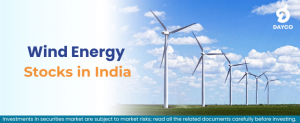Top Wind Energy Companies in India
![]() June 29, 2024
June 29, 2024
![]() 0 Comments
0 Comments
With its growing population and rising energy needs, India has recently had to deal with the difficult task of juggling power generation with environmental obligations. The country’s carbon footprint has also increased as a result of its growing population, which accounted for 1.44 billion in January 2024 (According to a report by a statistical firm, DataReportal); the government wishes to monitor that. In the wake of these rising environmental concerns, the emphasis has switched from using fossil fuels to other renewable energy sources.
India can produce energy without damaging the environment and lessen its reliance on fossil fuels by harnessing practically endless resources. However, this proposition to diversify comes with a challenge: reconciling energy needs with environmental responsibilities. India's reliance on fossil fuels has increased its carbon impact to alarming proportions. In response, the nation is embarking on a renewable energy revolution, with wind energy emerging as a leader.
The Move Towards Sustainable Energy Sources
A major change has already taken place in the global energy sector. The use of renewable energy sources is increasing due to worries about resource depletion and climate change. Particularly wind energy is expanding astronomically because of its:
- Cleanliness and Sustainability: Wind farms use less fuel when they are established, which lowers their operating costs compared to traditional power plants.
- Environmental-friendly: In contrast to fossil fuel power plants, which contribute heavily to air and water pollution, wind turbines generate electricity with no hazardous emissions while in operation.
- Cost-effective: Wind farms require little fuel after installation, resulting in cheaper operating costs than fossil fuel facilities.
Viability of Wind Energy
One of the main causes of climate change is greenhouse gas emissions, which are largely caused by fossil fuels. Wind energy, on the other hand, is a renewable source. In general, wind energy generation is less harmful to the environment than a lot of different energy sources. With very few exceptions, wind turbines don't emit any pollutants into the air or water, and they don't need water to cool. Wind turbines may also lessen the amount of fossil fuel electricity generated, which lowers overall air pollution and carbon dioxide emissions.
A single wind turbine only requires a minimal footprint. Wind farms, often known as groups of wind turbines, can be found offshore in lakes or the ocean, on mountain ridges, or in open spaces.
Why is India in an Advantageous Position?
In India, wind energy is becoming a vital and dependable renewable energy source. Wind turbines erected in wind farms produce wind energy. The domestic wind power business in India is in the lead and has demonstrated steady growth in the wind energy domain. A robust ecosystem, project operation capabilities, and a manufacturing base of roughly 15,000 MW annually have been produced by the wind industry's growth. Currently, the nation possesses the fourth-highest installed wind capacity globally.
The government is encouraging private sector investment in wind power projects around the nation by offering a number of tax and financial benefits, including the ability to defer customs duties on specific wind energy generator components and the benefit of accelerated depreciation. Further, wind projects that were put into service before March 31, 2017, qualified for the Generation Based Incentive (GBI) Scheme.
Since wind is a site-specific and intermittent energy source, choosing suitable locations requires a thorough Wind Resource Assessment. Over 900 wind-monitoring stations have been erected nationwide by the government through the National Institute of Wind Energy (NIWE), and wind potential maps at 50, 80, 100, 120, and 150 metres above sea level have been released. The most recent assessment indicates that the gross wind power potential is 695.50 GW at 120 metres and 1163.9 GW at 150 metres above ground.
Top Wind Energy Companies Listed In NSE and BSE
Individuals who invest in wind energy equities can help India achieve its sustainable energy goals while potentially earning a financial return. Here are some of the listed wind energy companies in India found on the NSE and BSE:
Suzlon Energy Limited
Suzlon, one of the largest wind energy businesses to emerge from India, is a true market leader in wind turbine production. The company began operations in 1995, and within two decades, it has established subsidiaries in over 30 countries throughout the world. Apart from manufacturing wind energy equipment, Suzlon also offers wind project planning and execution services and undertakes installation and operations & Maintenance of turbines. The organisation is currently capable of producing wind energy in excess of 23,000 megawatts. Suzlon plans to deploy 134 wind turbine generators (WTGs) with a Hybrid Lattice Tubular (HLT) tower and a rated capacity of around 3 MW for both projects at its proposed site in Fatehgarh, Rajasthan.
Indowind Energy Ltd.
The company, with headquarters in Chennai, specialises in developing wind farms, managing wind assets, and generating green power for utilities and corporate clients. They offer end-to-end wind power project services from concept to commissioning, provide comprehensive wind asset management, including operations, billing, and revenue collection, supply green power, and engage in carbon credit sales and trading.
Orient Green Power Ltd.
The company is engaged in the business of developing, owning, and producing electricity from renewable energy sources, primarily wind energy. The company is currently working on expanding its generation capacity from 400 to 1000 MW and is foraying into solar power. The states of Tamil Nadu, Andhra Pradesh, Gujarat, and Karnataka comprise the Company's portfolio of around 402.3 megawatts (MW) of wind assets. This company also includes a 10.5 MW wind farm in the Croatia area of Europe.
Adani Green Energy Limited
The wind energy division of the Indian corporation, Adani Green Energy Limited, presently owns utility-scale wind farms with a capacity of more than 1.2 GW. The corporation has set a target of 45 GW of renewable energy capacity by 2030, with its bigger renewable energy projects having a capacity exceeding 8 GW. Adani has also put a 130 MW wind power project in Kutchh into service.
Inox Wind Energy
Inox Wind is the top supplier of wind energy solutions in India, catering to corporates, retail investors, utilities, PSUs, and IPPs. Its business is spread into multiple areas - manufacturing of wind turbine generators, EPC, and operation & maintenance of wind farms. As a fully integrated operator in the wind energy industry, it has three production facilities with a combined 1,600 MW manufacturing capacity located in Gujarat, Himachal Pradesh, and Madhya Pradesh.
Things to Remember While Investing in Wind Energy Stocks
Even though wind energy stocks in India have great potential for profit, research is essential before investing. Here are some factors to research:
- Market Fluctuations: The stock market is subject to constant ups and downs. It’s essential that you enter any stock at a reasonable valuation to minimise the risk of large volatility and maximise your return potential.
- Performance of the Company: Analysing the track record, financial health, and the future of wind energy would also be wise before investing in it.
- Any Government Regulations: Government policy changes may have an impact on the wind energy industry.
- Advancement in Wind Technology: Technological developments in wind turbines can impact a company's ability to compete.
In the End
India has a lot of potential growth in its wind energy sector. Top wind energy stocks in India provide investors the chance to make lucrative returns while also helping India achieve its sustainable energy targets. Remember that before making any investment decisions, thorough investigation and assessment of the linked risks are essential.
-Nischay Avichal
Share With
I'm a cool paragraph that lives inside of an even cooler modal. Wins!
Are you sure?
In case you didnt know, you can open your account online within 24 hours. Offline account opening takes up to 4 working days. If you wish to open your account offline, fill and sign the forms using a black/blue ballpoint pen. Please fill in the email and mobile number of the applicant to avoid account opening delays.
Enter Password
Please enter your details and password
New to Dayco?
Enter Password
Please enter your details and password
New to Dayco?
Filing Complaints on SCORES (SEBI) – Easy & Quick
- Register on SCORES Portal (SEBI)
- Mandatory details for filing complaints on SCORES:
- Name, PAN, Address, Mobile Number, E-mail ID
- Benifits:
- Effective Communication
- Speedy redressal of the grievances
Thanks !!
Your details were successfully received.

Thank you for Your Feedback!
Our Team is working constantly on improving our user experience and your feedback really means a lot.
Thanks !!
App Link Send to your mobile number successfully.
Thank You
All your Questions have been recorded
Thank You
All your Questions have been recorded
Thank You!
Thank you for your response. We'll get in touch with you at the earlisest for your investment planning needs
NEXT
Thank You!
Thank You for your interest in our Moderate Equity Portfolio. Please find below the credentials to track this portfolio:
User ID: mockmod@daycoindia.com
Password: abcd@1234
Portfolio Tracker
Please Read!
Risk profiling is crucial for identifying and managing potential risks in investment decisions. Please carry out your risk profiling before making any investment decisions.
Complete Risk Assessment Now
Thank You !!
Please enter your details to download/print the report
Thank You !!
Please enter your details to download/print the report
Thank You !!
Please enter your details to download/print the report
Thank You !!
Please enter your details to download/print the report
Thank You !!
Please enter your details to download/print the report
Set Your Goal
Please Select an option from below
Set Your Goal
Please Select an option from below
Thanks You !
We appreciate your interest in our services. Our team will be in touch with you shortly.
CloseSet your Goal
Please enter your details in the fields provided
Thanks You!!
Calculation report has been sent to your mail id successfully
Clear form?
This will remove your answers from all questions and cannot be undone.



 Book Appointment
Book Appointment









Leave a Reply